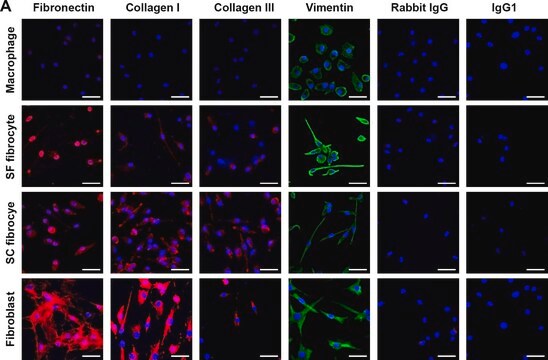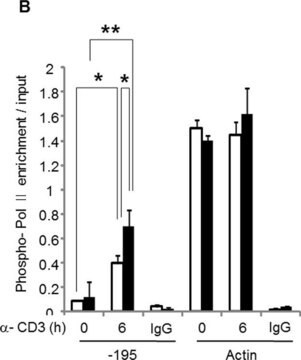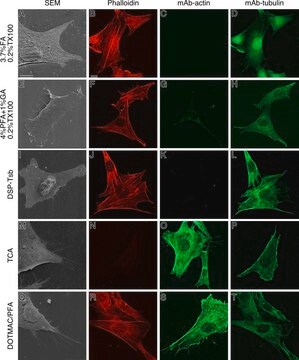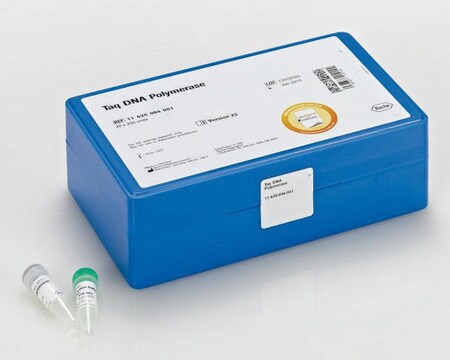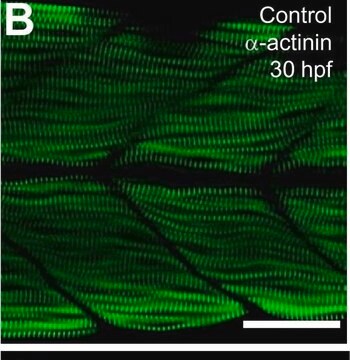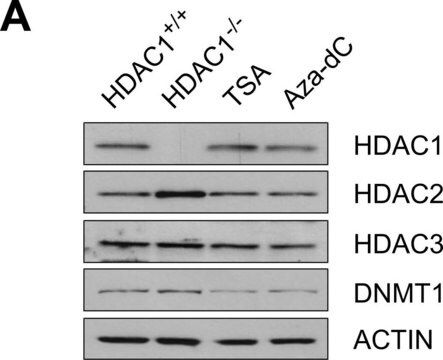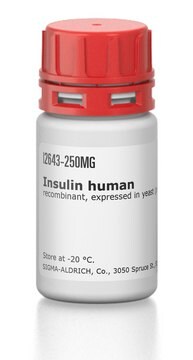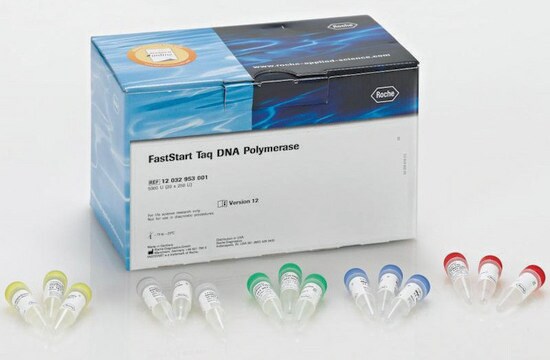推荐产品
一般說明
All ChIPAb+ antibodies are individually validated for chromatin precipitation, every lot, every time. Each ChIPAb+ antibody set includes control primers (tested every lot by qPCR) to biologically validate your IP results in a locus-specific context. The qPCR protocol and primer sequences are provided, allowing researchers to validate ChIP protocols when using our antibody in their chromatin context. Each set also includes a negative control antibody to ensure specificity of the ChIP reaction.
The ChIPAb+ RNA Pol II set includes the RNA Pol II antibody, the negative control antibody (mouse IgG), and qPCR primers flanking the human GAPDH promoter, yielding a 166 bp product. The RNA Pol II and negative control antibodies are supplied in a scalable "per ChIP" reaction size and can be used to functionally validate the precipitation of RNA Pol II associated chromatin.
The ChIPAb+ RNA Pol II set includes the RNA Pol II antibody, the negative control antibody (mouse IgG), and qPCR primers flanking the human GAPDH promoter, yielding a 166 bp product. The RNA Pol II and negative control antibodies are supplied in a scalable "per ChIP" reaction size and can be used to functionally validate the precipitation of RNA Pol II associated chromatin.
DNA-dependent RNA polymerase catalyzes the transcription of DNA into RNA using the four ribonucleoside triphosphates as substrates. Largest and catalytic component of RNA polymerase II which synthesizes mRNA precursors and many functional non-coding RNAs. Forms the polymerase active center together with the second largest subunit. Pol II is the central component of the basal RNA polymerase II transcription machinery. It is composed of mobile elements that move relative to each other. RPB1 is part of the core element with the central large cleft, the clamp element that moves to open and close the cleft and the jaws that are thought to grab the incoming DNA template. At the start of transcription, a single-stranded DNA template strand of the promoter is positioned within the central active site cleft of Pol II. A bridging helix emanates from RPB1 and crosses the cleft near the catalytic site and is thought to promote translocation of Pol II by acting as a ratchet that moves the RNA-DNA hybrid through the active site by switching from straight to bent conformations at each step of nucleotide addition. During transcription elongation, Pol II moves on the template as the transcript elongates. Elongation is influenced by the phosphorylation status of the C-terminal domain (CTD) of Pol II largest subunit (RPB1), which serves as a platform for assembly of factors that regulate transcription initiation, elongation, termination and mRNA processing. Acts as an RNA-dependent RNA polymerase when associated with small delta antigen of Hepatitis delta virus, acting both as a replicate and transcriptase for the viral RNA circular genome
特異性
Other species predicted to cross-react based upon sequence conservation are rat and yeast.
Recognizes RNA Pol II
免疫原
The RNA Pol II antibody is made against a peptide corresponding to the C-terminal domain of RNA Pol II.
應用
RNA Pol II ChIP validated antibody & primer set including the ChIP-grade antibody & the specific control PCR primers. The antibody ChIP is used for chromatin immunoprecipitation of RNA Pol II .
Research Category
Epigenetics & Nuclear Function
Epigenetics & Nuclear Function
Research Sub Category
Chromatin Biology
Chromatin Biology
Western Blot Analysis:
3T3 nuclear extract was resolved by electrophoresis, transferred to nitrocellulose and probed with anti-RNA polymerase II (0.1 μg/mL). Proteins were visualized using a goat anti-mouse secondary antibody conjugated to HRP and a chemiluminescence detection system (Please see figures).
3T3 nuclear extract was resolved by electrophoresis, transferred to nitrocellulose and probed with anti-RNA polymerase II (0.1 μg/mL). Proteins were visualized using a goat anti-mouse secondary antibody conjugated to HRP and a chemiluminescence detection system (Please see figures).
包裝
25 assays per set. ~1 μg per chromatin immunoprecipitation
品質
Routinely evaluated by chromatin immunoprecipitation on HeLa nuclear extract.
標靶描述
210-220 kDa
外觀
Protein G Purified
Anti-RNA Pol II (mouse monoclonal IgG1,purified). One vial containing 25 μg of purified antibody in 25 μL volume. Store at -20°C.
Normal Mouse IgG. One vial containing 25 ug of mouse IgG in 25 μL volume. Store at -20°C.
Control Primers p21. One vial containing 75 μL of 5 μM of each primer specific for a region of the human GAPDH promoter. Store at -20°C.
FOR: TAC TAG CGG TTT TAC GGG CG
REV: TCG AAC AGG AGG AGC AGA GAG
CGA
Normal Mouse IgG. One vial containing 25 ug of mouse IgG in 25 μL volume. Store at -20°C.
Control Primers p21. One vial containing 75 μL of 5 μM of each primer specific for a region of the human GAPDH promoter. Store at -20°C.
FOR: TAC TAG CGG TTT TAC GGG CG
REV: TCG AAC AGG AGG AGC AGA GAG
CGA
Format: Purified
儲存和穩定性
Stable for 1 year at -20°C from date of receipt.
分析報告
Control
Included negative control antibody mouse IgG and control primers specific for human GAPDH.
Included negative control antibody mouse IgG and control primers specific for human GAPDH.
法律資訊
UPSTATE is a registered trademark of Merck KGaA, Darmstadt, Germany
免責聲明
Unless otherwise stated in our catalog or other company documentation accompanying the product(s), our products are intended for research use only and are not to be used for any other purpose, which includes but is not limited to, unauthorized commercial uses, in vitro diagnostic uses, ex vivo or in vivo therapeutic uses or any type of consumption or application to humans or animals.
儲存類別代碼
10 - Combustible liquids
Mai N Tran et al.
The Journal of biological chemistry, 288(5), 3275-3288 (2012-12-15)
Epithelial-mesenchymal transition (EMT) is a physiological process that plays important roles in tumor metastasis, "stemness," and drug resistance. EMT is typically characterized by the loss of the epithelial marker E-cadherin and increased expression of EMT-associated transcriptional repressors, including ZEB1 and
Rbfox1 downregulation and altered calpain 3 splicing by FRG1 in a mouse model of Facioscapulohumeral muscular dystrophy (FSHD).
Pistoni, M; Shiue, L; Cline, MS; Bortolanza, S; Neguembor, MV; Xynos, A; Ares, M; Gabellini, D
PLoS Genetics null
Qingxiu Zhang et al.
Glia, 70(11), 2079-2092 (2022-07-03)
The pro-inflammatory cytokine interleukin 17 (IL-17), that is mainly produced by Th17 cells, has been recognized as a key regulator in multiple sclerosis (MS) and experimental autoimmune encephalomyelitis (EAE). Reactive astrocytes stimulated by proinflammatory cytokines including IL-17 are involved in
Daniel Calva et al.
Nucleic acids research, 39(13), 5369-5378 (2011-03-23)
Inactivation of SMAD4 has been linked to several cancers and germline mutations cause juvenile polyposis (JP). We set out to identify the promoter(s) of SMAD4, evaluate their activity in cell lines and define possible transcription factor binding sites (TFBS). 5'-rapid
Ailing Li et al.
The Journal of clinical investigation, 123(10), 4195-4207 (2013-09-21)
The embryonic self-renewal factor SALL4 has been implicated in the development of human acute myeloid leukemia (AML). Transgenic mice expressing the human SALL4B allele develop AML, which indicates that this molecule contributes to leukemia development and maintenance. However, the underlying
我们的科学家团队拥有各种研究领域经验,包括生命科学、材料科学、化学合成、色谱、分析及许多其他领域.
联系技术服务部门